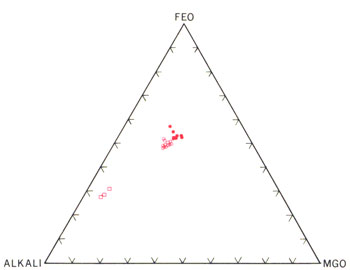Komagatake Volcano
1: Introduction / Geology of Komagatake Volcano and environs / Outline of Komagatake Volcano
2: Geology and history of activities of Komagatake Volcano
3: Eruptions of Komagatake Volcano in historical times
4: Rocks of Komagatake Volcano
5: Surveillance and observation of volcanc activities - Future surveillance and prevention of disaster
6: References
![]() PREV
PREV ![]() NEXT
NEXT
4: Rocks of Komagatake Volcano
Essential ejecta of Komagatake are, irrespective to their occurrences, mostly augite-hypersthene andesite and rarely olivine-bearing. Just one example of quartz- hypersthene andesite dike is known to occur. Their lithologic characteristics are as follows;
In general, they are characteristically porphyritic with abundance of phenocrysts. Phenocrysts include plagioclase, hypersthene, augite, olivine, and iron titanate mineral.
Plagioclase is most abundant and shows complex pattern of repeated zonal textures with inclusions of glass and hypersthene. Hypersthene is next abundant. Often it is intergrown or shows glomeroporphyritic growth with augite and contains plagioclase and glass. Augite often shows glomeroporphyritic growth with hypersthene and plagioclase. Olivine is only found in part of Komagatake lava. It is corroded and contains iron titanate mineral and glass. Iron titanate mineral is small in abundance and in general occurs as small-sized phenocrysts.
Groundmass of lava shows pilotaxitic to hyalopilitic texture and consists of plagioclase, hypersthene, clinopyroxene, iron titanate mineral, and glass. Somewhat crystalline lava has fair amount of tridymite in it. Pumice is very vesicular and mostly glass with little amount of acicular plagioclase and fine-grained iron titanate mineral. Scoria contains many grains of iron titanate mineral. Welded tuff varies considerably in groundmass textures and compositions depending on both the degrees of welding and gaseous alterations. In strongly welded Sahara-Dake welded tuff, pumice and glass fragments are densely compressed and show eutaxitic texture resulting in cryptocrystalline texture as a whole with abundant tridymite crystallized in vesicles. In the whole body (in particular in upper unit) of Dekimazaki welded tuff, degrees of welding is low. Pumice and glass fragments are only slightly stretched, lightly welded, and recrystallization weak. Glass fragments remain glassy. In the summit fissure of 1942, lower half of thick pumice bed deposited at the bottom of crater is welded with strong gaseous alteration well developed between welded lower part and non-welded upper part. In the welded part groundmass glass is completely recrystallized and crystallites of tridymite and others are well developed.
Representative chemical compositions of Komagatake Volcano analyzed with XRF are shown in ![]() Table 3. In the past analyses, SiO2 of most rocks are within a small range of 60±2 %, that correspond to intermediate andesite, and there was no significant difference between 1929 ejecta and pre-historical ejecta. However, as is clear from
Table 3. In the past analyses, SiO2 of most rocks are within a small range of 60±2 %, that correspond to intermediate andesite, and there was no significant difference between 1929 ejecta and pre-historical ejecta. However, as is clear from ![]() Table 3, pumice of historical times is slightly richer in SiO2 and alkalis, and poorer in FeO, MgO, and CaO as compared to lavas of stratovolcano stage of development.
Table 3, pumice of historical times is slightly richer in SiO2 and alkalis, and poorer in FeO, MgO, and CaO as compared to lavas of stratovolcano stage of development.
General characteristics in chemical compositions of Komagatake Volcano are well within those of intermediate calcalkaline rocks. However, as compared to intermediate andesites, those of Komagatake are rather poor in K2O. The differentiation path of Komagatake rocks follow that of typical calcalkaline rock series in which alkalis increase while total iron decreases with increasing SiO2 ( ![]() Fig.8 ).
Fig.8 ).
In SW Hokkaido, ejecta of Tarumae Volcano are similar to that of Komagatake Volcano in chemical compositions. It is noteworthy that the pattern of volcanic activities of both volcanoes is also similar. However, chemical compositions of ejecta of Tarumae Volcano is about 2 % lower in SiO2 and slightly lower in Na2O in average as compared to those of Komagatake.
Bulk rock composition of Komagatake corresponds to andesitic magma, but the mode of eruption is very explosive. The mode of eruption is ruled by physical characters of magma, in particular, chemical composition. Kozu and Seto ( 1931 ) reported that chemical composition of groundmass glass of 1929 eruption was SiO2 at 74 % corresponding to rhyolite. Similarly pumice groundmass glass compositions of 1640 and 1856 eruptions were rhyolitic and rich in SiO2 with poor total iron. Rhyolitic magma such as these is interpreted to have evolved during dormant stage of activities by abundant crystallization and resultant removal of plagioclase, pyroxene, and iron titanate phenocrysts. This process progressed under high water vapor pressure and high partial pressure of oxygen. H2O and other volatile components concentrated at the upper part of magma reservoir. It is understood that rhyolitic magma with high water vapor pressure violently vesiculates and comminute when erupting and resulting in Plinian eruption. As eruption proceeds, the bottom of magma reservoir where less water is concentrated and viscosity is high could appear to the surface forming lava dome. During eruption of 1856 a small lava dome was formed within the Ansei crater at the end of eruption. This may be an example of the above process.

